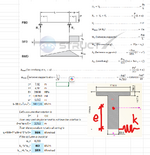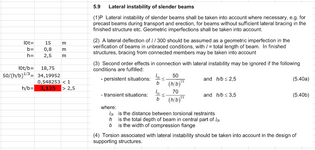user277418
Structural
Hi
A case:
A transfer structure of a building. Three parallel post-tensioned (PT) continuous transfer girders are holding several storeys frome above. The girders are formed from a web WIDTHxHEIGHT=0.8x2.5m + a PT slab 0.28 m thick on top (i.e. a composite T-section. Going to be casted in 2 stages). The girders are sitting on top of relatively narrow and slender columns 0.58x0.58 m. Step of the columns is about 10 m along the girders. Every girder has 4 spans. Since the girders have so deep webs (almost 1 storey height) I am considering provision of transverse diaphragms of the same height as the girders over the columns (transversely to longitudinal axis of the girders). By analogy to the diaphragms over piers in construction of bridges. I am worried about out-of-plane instability of the girders since they are exceptionally deep, continuous and have unbraced bottom of the web in the zone of hogging bending moments.
A problem:
For me the provision of the diaphragms seems logical. However I have a very strong suspicion that my project manager would not appreciate it unless I am going to bring him some solid prove that they must be provided (HVAC engineer has already reserved the space for passing his ducts). Eurocode is almost silent regarding instability of reinforced concrete beams. LTB of steel-concrete composite girders restrained by cast-insitu concrete slabs may be of some help, but is not directly applicable. Most of available publications are discussing instability of precast prestressed girders during construction or lifting. The publications can hardly be applied to my case since my girders are going to be fully supported during construction. My main concern is about final state.
As an alternative to the diaphragms I am thinking about an option of designing the column to girder joints for a notional lateral force (NLF) applied normal to the girders plane. The NLF is going to be equal to a maximum hogging bending moment over the columns divided onto depth of the girder. Additionally to the amplified bending moment according to EC.
Answers I am looking for:
- Do you consider such case to be a problem at all? Regarding instability of RC girders
- Do you know any publications describing design of similar cases or behavior of continuous reinforced concrete beams of such depth? Seems to me, design of cast-insitu bridge girders may have some similarities.
- What do you think about the notional lateral force instead of the diaphragm? I prefer diaphragms
Any opinion is appreciated,
Best regards
A case:
A transfer structure of a building. Three parallel post-tensioned (PT) continuous transfer girders are holding several storeys frome above. The girders are formed from a web WIDTHxHEIGHT=0.8x2.5m + a PT slab 0.28 m thick on top (i.e. a composite T-section. Going to be casted in 2 stages). The girders are sitting on top of relatively narrow and slender columns 0.58x0.58 m. Step of the columns is about 10 m along the girders. Every girder has 4 spans. Since the girders have so deep webs (almost 1 storey height) I am considering provision of transverse diaphragms of the same height as the girders over the columns (transversely to longitudinal axis of the girders). By analogy to the diaphragms over piers in construction of bridges. I am worried about out-of-plane instability of the girders since they are exceptionally deep, continuous and have unbraced bottom of the web in the zone of hogging bending moments.
A problem:
For me the provision of the diaphragms seems logical. However I have a very strong suspicion that my project manager would not appreciate it unless I am going to bring him some solid prove that they must be provided (HVAC engineer has already reserved the space for passing his ducts). Eurocode is almost silent regarding instability of reinforced concrete beams. LTB of steel-concrete composite girders restrained by cast-insitu concrete slabs may be of some help, but is not directly applicable. Most of available publications are discussing instability of precast prestressed girders during construction or lifting. The publications can hardly be applied to my case since my girders are going to be fully supported during construction. My main concern is about final state.
As an alternative to the diaphragms I am thinking about an option of designing the column to girder joints for a notional lateral force (NLF) applied normal to the girders plane. The NLF is going to be equal to a maximum hogging bending moment over the columns divided onto depth of the girder. Additionally to the amplified bending moment according to EC.
Answers I am looking for:
- Do you consider such case to be a problem at all? Regarding instability of RC girders
- Do you know any publications describing design of similar cases or behavior of continuous reinforced concrete beams of such depth? Seems to me, design of cast-insitu bridge girders may have some similarities.
- What do you think about the notional lateral force instead of the diaphragm? I prefer diaphragms
Any opinion is appreciated,
Best regards
Last edited:


